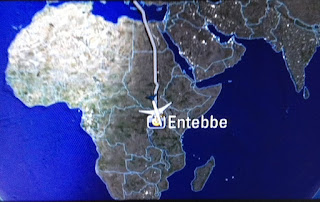I have spent the last year studying these ceremonies, how they are performed, and the impact they have on the communities to perform them. The conclusion I had come to is that whether you believe in spirits or not, whether you could understand these rituals or could not, these ceremonies have a massive impact on community healing, the ability to welcome back former child soldiers, and the opportunity for reconciliation. I could not pass up the opportunity to go, but I did have to prepare myself; I was going to see an animal get sacrificed. Not just one, but two. Now, I have been a vegetarian for nine years for many reasons, one of which is certainly my love for animals. And while I have never looked down on anyone else for eating meat, this was taking it to an entirely different level. My goals for the day were: don't freak out, don't try to set the animals free, and don't try to save them when the time comes for the sacrifice. While these are my impulses, they are in direct conflict with my belief that these ceremonies are important and can help people overcome the things they have gone through.
We woke up early and left at 6:30am to head to the village. The start of the day was being guided through the events that had taken place during the war, and how these related to the community's current situation; seeing spirits at night, hearing things on the roof, etc. The areas where events had occurred were areas where many community members would not set foot. We went to the sites, we heard the stories from two survivors, and we were able to ask questions and document different information about the site. The elders then arrived and were formally introduced. The purposes and processes of the ceremony were described, as well as the history and effects of the war on the community, and then we all went down to the site; elders, community members, and observers.
The sacrifice is symbolic of innocence and suffering, and for this particular ceremony, the cleansing of an area, it required a goat and a sheep. It is done quickly and skillfully, and is performed by the elders in the clan. While I tried to keep my distance, I saw more than I had hoped to. I did, however, handle it well. After the sacrifice, the elders went to the different sites and performed the rituals, and then the animals were prepared for a feast. This, I was able to avoid. I sat on the grass behind a tree out of view of the preparation. We were then called to the organizers house, where we talked and ate with the elders. After we were done (I managed to politely decline the meat portion of the meal), myself and a coworker went outside to interview the community and document their stories. This was my favorite part. He is part of the media team, and creates these fantastic short films to give voice to the community's perspective on a variety of issues related to the conflict. It was wonderful to see him work and see how he interacts with people. During the interviews there was no way to translate, but he shared their stories with me after each interview. While the stories are full of pain and suffering, there is this resiliency there and a desire to share their story to help others. And there was a lot of resiliency on his part too; he hears these stories every day, and handles them with compassion and a great deal of hope.
As we waited for our ride to return, we laid on a mat on the grass, and reflected on the day. We discussed when we would return and see whether the ceremony had been effective, what went well and what could've been done better, and the differences between this ceremony and the one that had been done previously. Another NGO had attempted a ceremony before, but the community explained that they did it without everyone present (many were still in Internally Displaced Person camps), and it was not done properly. The result was anger in the community and the spirits haunting them remained. This was another example of how important it is to know the cultural context, and with RLP's approach, I'm confident that this one went better than the last. I hope I get the chance to find out while I'm still here.
As we waited for our ride to return, we laid on a mat on the grass, and reflected on the day. We discussed when we would return and see whether the ceremony had been effective, what went well and what could've been done better, and the differences between this ceremony and the one that had been done previously. Another NGO had attempted a ceremony before, but the community explained that they did it without everyone present (many were still in Internally Displaced Person camps), and it was not done properly. The result was anger in the community and the spirits haunting them remained. This was another example of how important it is to know the cultural context, and with RLP's approach, I'm confident that this one went better than the last. I hope I get the chance to find out while I'm still here.














